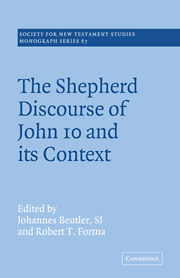Book contents
- Frontmatter
- Contents
- List of abbreviations
- Introduction
- 1 Open questions on John 10
- 2 Der alttestamentlich-jüdische Hintergrund der Hirtenrede in Johannes 10
- 3 The history of religions background of John 10
- 4 Tradition, history and interpretation in John 10
- 5 John 10 and its relationship to the Synoptic Gospels
- 6 A syntactical and narratological reading of John 10 in coherence with chapter 9
- 7 Johannes 10 im Kontext des vierten Evangeliums
- Notes
- Index
4 - Tradition, history and interpretation in John 10
Published online by Cambridge University Press: 10 October 2009
- Frontmatter
- Contents
- List of abbreviations
- Introduction
- 1 Open questions on John 10
- 2 Der alttestamentlich-jüdische Hintergrund der Hirtenrede in Johannes 10
- 3 The history of religions background of John 10
- 4 Tradition, history and interpretation in John 10
- 5 John 10 and its relationship to the Synoptic Gospels
- 6 A syntactical and narratological reading of John 10 in coherence with chapter 9
- 7 Johannes 10 im Kontext des vierten Evangeliums
- Notes
- Index
Summary
John 10 is a complex chapter. Problems arise for the interpreter because of questions about the relation of the chapter to the rest of the Gospel as well as doubts about the order of the chapter itself. Special features, such as the aμήν-sayings, the παριíα and the έγώ εiμι-sayings, also complicate the task of interpretation.
Chapters 5–10 form an important section of the gospel in which the great debates and disputes take place. These chapters focus on conflict with ‘the Jews’. The first reference to the persecution of Jesus (5:16) is followed by the first account of an attempt to kill him (5:18). Persecution was a consequence of his having broken the Sabbath, and the attempt to kill him followed because he justified his action (work, eργν) by appeal to his relation to the Father (5:17–18), a theme taken up in 10:14–18, 29–39, where another attempt to kill (stone) Jesus is described. Attempts to arrest or kill Jesus run through these chapters (5:16, 18; 7:19, 20, 25, 32, 44; 8:20, 59; 10:31–3, 39). The implicit charge against Jesus in 5:18 is explicitly spelt out as blasphemy in 10:33. But in chapter 10 Jesus' appeal to his works is made to justify his claimed relation with the Father (10:25, 37–8) whereas, in chapter 5, his appeal to his relation to the Father justifies his work (5:17). Thus, in typical Johannine fashion, the claimed relation is used to justify the work and the works are used to justify the claim.
- Type
- Chapter
- Information
- The Shepherd Discourse of John 10 and its Context , pp. 53 - 74Publisher: Cambridge University PressPrint publication year: 1991
- 1
- Cited by



